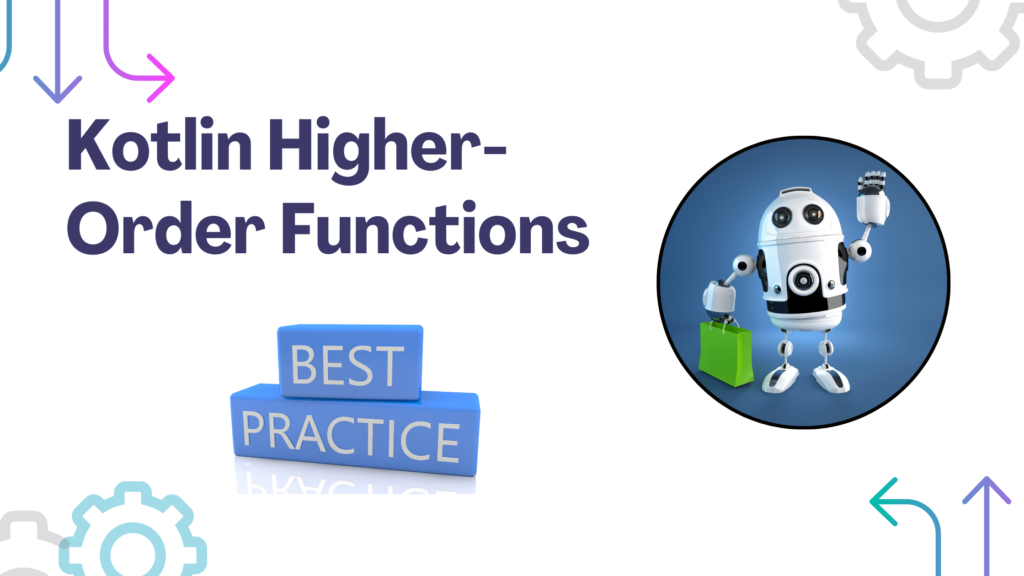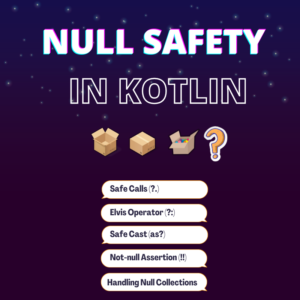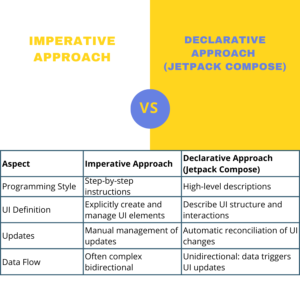Advanced Functions

What are higher-order function in Kotlin?
Advanced functions are like powerful tools in a magician’s arsenal. They allow programmers to create flexible, reusable, and elegant solutions in their Android applications. But before we dive into the magic, let’s understand why these functions are so essential in the world of programming.
In simpler terms, imagine you are building a virtual robot. Basic functions are like the robot’s hands – they can pick up things and put them down. But advanced functions? They are like the robot’s brain! They can analyze situations, make decisions, and perform complex tasks.
Table of Contents
Common Patterns
Have you ever noticed that in many Android apps, certain tasks keep popping up? Like handling lists of items, processing data, or managing user interactions? These are like the recurring themes in our programming story. Advanced functions provide elegant solutions to these patterns, making your code shorter, smarter, and easier to maintain.
What is the advantage of higher-order function in Kotlin?
Higher-order functions are like recipe books that can create endless dishes. They are functions that can take other functions as ingredients and even serve functions as outcomes! Just as chefs create unique recipes by combining various ingredients, programmers craft exceptional solutions by combining functions. This flexibility allows us to build complex behaviors and applications effortlessly.
In Kotlin, functions are considered first-class citizens, which means they can be treated like any other data type, such as integers or strings.
Higher-order functions are a powerful feature of Kotlin that allows you to treat functions as variables, pass them as arguments to other functions, or return them from other functions. This concept is similar to how you can work with objects or data.
Higher-order functions can make your code more concise and expressive by enabling you to write more reusable and flexible code
Here are the main aspects of higher-order functions in Kotlin:
- Functions as Parameters:
- Higher-order functions can take other functions as parameters. The parameter function’s signature (parameter types and return type) is specified as part of the higher-order function’s declaration.
- Example:
fun higherOrderFunction(operation: (Int, Int) -> Int) {
val result = operation(5, 3)
println("Result: $result")
}
// Example of calling the higher-order function with a lambda as a parameter
higherOrderFunction { a, b -> a + b }
Functions as Return Types:
- Higher-order functions can also return functions. The return type of the higher-order function includes the signature of the function that will be returned.
- Example:
fun getOperation(): (Int, Int) -> Int {
return { a, b -> a * b }
}
// Example of calling the higher-order function to get a function, and then using that function
val operation = getOperation()
val result = operation(4, 3)
println("Result: $result")
Lambda Expressions:
- Lambda expressions are a concise way to define functions and are often used as parameters for higher-order functions.
- Example:
val multiply: (Int, Int) -> Int = { a, b -> a * b }
val sum: (Int, Int) -> Int = { a, b -> a + b }
// Example of using higher-order functions with lambda expressions
higherOrderFunction(multiply)
higherOrderFunction(sum)
Examples of higher-order functions in Android

Let’s consider a practical Android use case where higher-order functions can be beneficial. Suppose you have a list of numbers, and you want to perform various operations on these numbers, such as finding the sum, the maximum value, or the minimum value. Instead of writing separate functions for each operation, you can use higher-order functions to make your code more flexible and reusable.
Consider this code example:
// Define a higher-order function called 'operateOnNumbers'
fun operateOnNumbers(a: Int, b: Int, operation: (Int, Int) -> Int): Int {
val result = operation(a, b)
return result
}
// Define a function for addition
fun add(a: Int, b: Int): Int {
return a + b
}
// Define a function for multiplication
fun multiply(a: Int, b: Int): Int {
return a * b
}
fun main() {
val num1 = 10
val num2 = 5
// Example 1: Using 'operateOnNumbers' with the 'add' function
val sum = operateOnNumbers(num1, num2, ::add)
println("Sum: $sum") // Output: Sum: 15
// Example 2: Using 'operateOnNumbers' with the 'multiply' function
val product = operateOnNumbers(num1, num2, ::multiply)
println("Product: $product") // Output: Product: 50
}
Now, let’s break down the code step by step:
- We start by defining a higher-order function called
operateOnNumbers. This function takes three arguments:aandbare two integers that you want to perform an operation on.operationis a higher-order function that takes two integers and returns an integer. Thisoperationfunction represents the math operation you want to perform (e.g., addition or multiplication).
- We define two regular functions,
addandmultiply, which represent specific math operations. These functions take two integers (aandb) and return the result of the operation. - In the
mainfunction, we have two numbers,num1andnum2, that we want to perform operations on. - Example 1: We use the
operateOnNumbersfunction with theaddfunction as theoperationargument. This means we’re telling theoperateOnNumbersfunction to use theaddfunction to addnum1andnum2. The result is stored in thesumvariable, which is then printed. - Example 2: Similarly, we use the
operateOnNumbersfunction with themultiplyfunction as theoperationargument. This time, we’re telling it to use themultiplyfunction to multiplynum1andnum2. The result is stored in theproductvariable and printed.
The key idea here is that we can pass functions (add and multiply) as arguments to the operateOnNumbers function. This makes operateOnNumbers flexible, as it can perform different operations based on the function provided as an argument. This is the essence of higher-order functions in Kotlin – functions that can accept other functions as parameters to customize their behavior.
Android application, and we want to perform various operations on these tasks using higher-order functions, functions as parameters, functions as return types, and lambda expressions.
Problem: Managing Tasks in an Android App
Imagine you have a list of tasks with the following data structure:
data class Task(val id: Int, val description: String, val priority: Int)
You want to perform the following operations:
- Filter tasks based on priority.
- Transform task descriptions to uppercase.
- Find a task with the highest priority.
- Print all tasks using a custom formatter.
Now, let’s write Kotlin code to solve these problems using higher-order functions:
data class Task(val id: Int, val description: String, val priority: Int)
fun main() {
val tasks = listOf(
Task(1, "Complete project", 2),
Task(2, "Read a book", 1),
Task(3, "Go for a run", 3),
Task(4, "Write a report", 2)
)
// 1. Filter tasks based on priority
val highPriorityTasks = filterTasks(tasks) { task -> task.priority > 2 }
printTasks("High Priority Tasks:", highPriorityTasks)
// 2. Transform task descriptions to uppercase
val uppercaseDescriptions = transformTasks(tasks) { task -> task.description.toUpperCase() }
printTasks("Uppercase Descriptions:", uppercaseDescriptions)
// 3. Find a task with the highest priority
val highestPriorityTask = findHighestPriorityTask(tasks)
println("Task with the highest priority: $highestPriorityTask")
// 4. Print all tasks using a custom formatter
printFormattedTasks(tasks) { task -> "${task.id}: ${task.description} [Priority: ${task.priority}]" }
}
// Higher-order function to filter tasks
fun filterTasks(tasks: List<Task>, predicate: (Task) -> Boolean): List<Task> {
return tasks.filter(predicate)
}
// Higher-order function to transform tasks
fun transformTasks(tasks: List<Task>, transformer: (Task) -> String): List<String> {
return tasks.map(transformer)
}
// Higher-order function to find the task with the highest priority
fun findHighestPriorityTask(tasks: List<Task>): Task? {
return tasks.maxByOrNull { it.priority }
}
// Higher-order function to print tasks with a custom formatter
fun printFormattedTasks(tasks: List<Task>, formatter: (Task) -> String) {
tasks.forEach { task ->
println(formatter(task))
}
}
// Helper function to print tasks
fun printTasks(header: String, tasks: List<*>) {
println(header)
tasks.forEach { println(it) }
println()
}
Explanation:
- Filtering Tasks (Higher-order function as a parameter):
- The
filterTasksfunction takes a list of tasks and a predicate function as parameters. - It uses the
filterhigher-order function to filter tasks based on the given predicate.
- The
- Transforming Task Descriptions (Higher-order function as a parameter):
- The
transformTasksfunction takes a list of tasks and a transformer function as parameters. - It uses the
maphigher-order function to transform task descriptions using the given transformer.
- The
- Finding the Highest Priority Task (Higher-order function as a return type):
- The
findHighestPriorityTaskfunction takes a list of tasks and returns a task with the highest priority. - It uses the
maxByOrNullhigher-order function.
- The
- Printing Tasks with a Custom Formatter (Higher-order function as a parameter):
- The
printFormattedTasksfunction takes a list of tasks and a formatter function as parameters. - It uses
forEachto iterate over tasks and print them using the provided formatter.
- The
Problem: Task Management in an Android To-Do App
Imagine you are building a to-do list app where tasks are stored in a local database, and you can fetch additional tasks from an API. You want to perform the following operations:
- Filter tasks by completion status: Retrieve only the completed or incomplete tasks.
- Transform task names: Convert task names to uppercase.
- Fetch tasks from API and store them locally: Fetch new tasks from an API and add them to the local database.
- Print tasks with a custom formatter: Display tasks in a formatted way in the UI.
Now, let’s write Kotlin code to solve these problems using higher-order functions:
data class Task(val id: Int, val name: String, val isCompleted: Boolean)
// Simulating a local database
class LocalDatabase {
private val tasks = mutableListOf<Task>()
fun getAllTasks(): List<Task> = tasks
fun addTasks(newTasks: List<Task>) {
tasks.addAll(newTasks)
}
}
// Simulating an API service
class TaskApiService {
fun fetchTasksFromApi(): List<Task> {
// Assume fetching tasks from an actual API
return listOf(
Task(101, "Read a book", false),
Task(102, "Write a report", true),
Task(103, "Go for a run", false)
)
}
}
fun main() {
val localDatabase = LocalDatabase()
val taskApiService = TaskApiService()
// 1. Filter tasks by completion status
val completedTasks = filterTasks(localDatabase.getAllTasks()) { task -> task.isCompleted }
printTasks("Completed Tasks:", completedTasks)
// 2. Transform task names to uppercase
val uppercaseTaskNames = transformTasks(localDatabase.getAllTasks()) { task -> task.name.toUpperCase() }
printTasks("Uppercase Task Names:", uppercaseTaskNames)
// 3. Fetch tasks from API and store them locally
val newTasksFromApi = taskApiService.fetchTasksFromApi()
localDatabase.addTasks(newTasksFromApi)
println("Tasks after fetching from API: ${localDatabase.getAllTasks()}")
// 4. Print tasks with a custom formatter
printFormattedTasks(localDatabase.getAllTasks()) { task ->
"${task.id}: ${task.name} [Completed: ${task.isCompleted}]"
}
}
// Higher-order function to filter tasks by completion status
fun filterTasks(tasks: List<Task>, predicate: (Task) -> Boolean): List<Task> {
return tasks.filter(predicate)
}
// Higher-order function to transform task names
fun transformTasks(tasks: List<Task>, transformer: (Task) -> String): List<String> {
return tasks.map(transformer)
}
// Higher-order function to print tasks with a custom formatter
fun printFormattedTasks(tasks: List<Task>, formatter: (Task) -> String) {
tasks.forEach { task ->
println(formatter(task))
}
}
// Helper function to print tasks
fun printTasks(header: String, tasks: List<*>) {
println(header)
tasks.forEach { println(it) }
println()
}
Explanation:
- Filtering Tasks (Higher-order function as a parameter):
- The
filterTasksfunction takes a list of tasks and a predicate function as parameters. - It uses the
filterhigher-order function to filter tasks based on the given predicate (completion status).
- The
- Transforming Task Names (Higher-order function as a parameter):
- The
transformTasksfunction takes a list of tasks and a transformer function as parameters. - It uses the
maphigher-order function to transform task names using the given transformer (convert to uppercase).
- The
- Fetching Tasks from API and Storing Locally (Higher-order function as a return type):
- The
fetchTasksFromApifunction inTaskApiServicereturns a list of tasks from the API. - The
addTasksfunction inLocalDatabaseadds new tasks to the local database. - This demonstrates the concept of functions as return types.
- The
- Printing Tasks with a Custom Formatter (Higher-order function as a parameter):
- The
printFormattedTasksfunction takes a list of tasks and a formatter function as parameters. - It uses
forEachto iterate over tasks and print them using the provided formatter.
- The
In this example, we use higher-order functions to perform common operations in a real-world Android project related to task management. These operations involve working with local databases, fetching data from an API, and displaying form
What are higher-order function methods?
Examples of higher-order functions in Kotlin
filterFunction:
val numbers = listOf(1, 2, 3, 4, 5, 6)
val evenNumbers = numbers.filter { it % 2 == 0 }
The filter function is a higher-order function that takes a lambda expression as an argument. In this example, we have a list of numbers, and we use the filter function to create a new list called evenNumbers that contains only the even numbers from the original list. The lambda expression { it % 2 == 0 } defines the condition for filtering, and it represents each element in the list.
2. map Function:
val numbers = listOf(1, 2, 3, 4, 5)
val squaredNumbers = numbers.map { it * it }
The map function is another higher-order function that takes a lambda expression. Here, we use it to create a new list squaredNumbers where each element is the square of the corresponding element in the original list.
3. forEach Function:
val fruits = listOf("apple", "banana", "cherry")
fruits.forEach { println("I like $it") }
The forEach function iterates over each element in the fruits list and performs the action specified in the lambda expression. In this case, it prints a message for each fruit.
4. run Function:
val result = run {
val x = 10
val y = 20
x + y
}
The run function is a higher-order function that takes a lambda expression and executes it. It returns the result of the lambda expression. In this example, the lambda calculates the sum of x and y, and the result is stored in the result variable.
5. Custom Higher-Order Function:
fun operateOnNumbers(a: Int, b: Int, operation: (Int, Int) -> Int): Int {
return operation(a, b)
}
val sum = operateOnNumbers(5, 3) { x, y -> x + y }
val product = operateOnNumbers(5, 3) { x, y -> x * y }
Here, we define a custom higher-order function called operateOnNumbers that takes two numbers and a function for an operation. It applies the provided operation to the numbers and returns the result. In the example, we use this function to calculate the sum and product of two numbers by passing in lambda expressions for addition and multiplication as the operation.
6. sortedBy Function:
data class Person(val name: String, val age: Int)
val people = listOf(Person("Alice", 30), Person("Bob", 25), Person("Charlie", 35))
val sortedByName = people.sortedBy { it.name }
The sortedBy function is a higher-order function used for sorting collections. In this example, we have a list of Person objects, and we use sortedBy to create a new list called sortedByName, which sorts the people by their names in alphabetical order.
7. reduce Function:
val numbers = listOf(1, 2, 3, 4, 5)
val sum = numbers.reduce { acc, number -> acc + number }
The reduce function is a higher-order function that combines the elements of a collection into a single value. In this example, it’s used to calculate the sum of all numbers in the list by repeatedly adding each number to an accumulator (acc).
8. any Function:
val numbers = listOf(1, 2, 3, 4, 5)
val containsEven = numbers.any { it % 2 == 0 }
The any function checks if at least one element in a collection satisfies a given condition (specified in the lambda expression). Here, it determines if the numbers list contains at least one even number.
9. groupBy Function:
data class Person(val name: String, val age: Int)
val people = listOf(
Person("Alice", 30),
Person("Bob", 25),
Person("Charlie", 35),
Person("David", 30)
)
val groupedByAge = people.groupBy { it.age }
The groupBy function is used to group elements of a collection based on a specified property. In this example, it groups people by their age property, resulting in a map where each age corresponds to a list of people of that age.
Kotlin Functions
| Functions | – Simple Functions – Function Parameters – Function Return Types – Function Scope |
| Specialized Functions | – Recursive Functions – Inline Functions – Higher-Order Extension Functions |
| Functional Programming Functions | – Immutability and Pure Functions- Function Composition – Functional Operators |

Feel free to follow and join my email list at no cost. Don’t miss out — sign up now!
Please check out my earlier blog post for more insights. Happy reading!
The Innovative Fundamentals of Android App Development in 2023
How to learn Android App Development in 2023 – Full Guide For Beginners using Kotlin Language
What is the Repository Pattern in Android? A Comprehensive Guide
What is ViewModel in Android? A Good Guide for Beginners
The Innovative Fundamentals of Android App Development in 2023
How to Say Goodbye to Activity Lifecycle and Say Hello to Compose Lifecycle ?
How to Monitor/Observe Network Availability for Android Projects
Exploring Sealed Class vs Enum in Kotlin Which is Best for Your Code?



